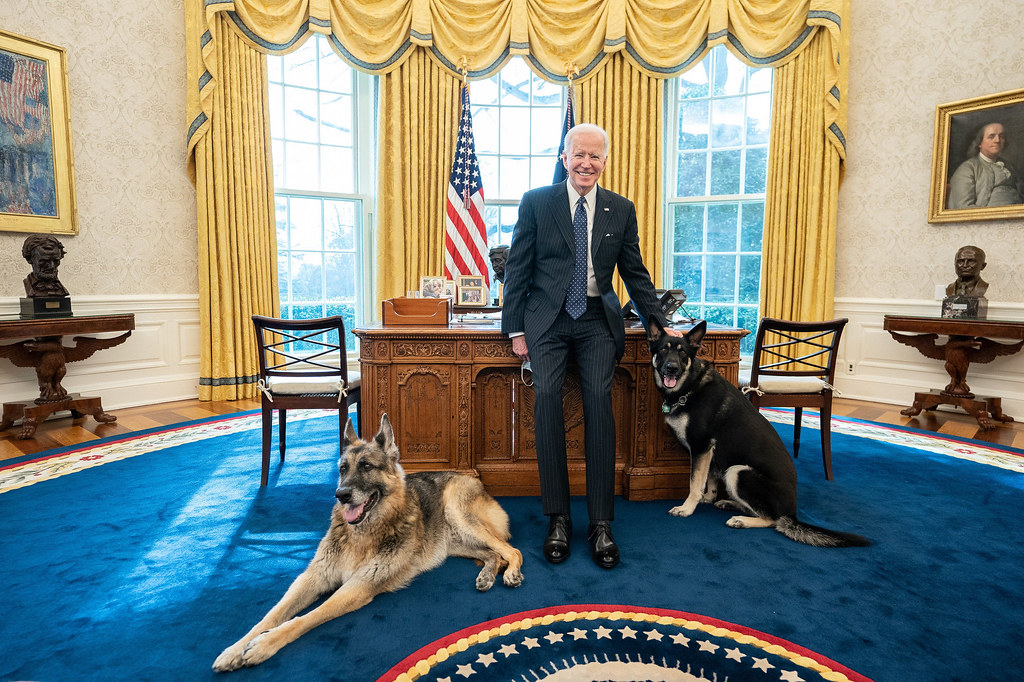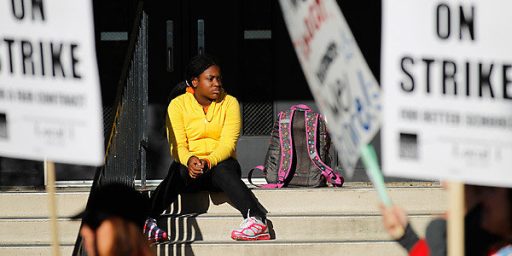Biden’s American Families Plan
The President is about to roll out another massive spending plan.

In a major address tonight on the eve of his 100th day in office, President Biden will reportedly introduce a massive investment in childcare, education, and health subsidies financed by higher corporate taxes. Interestingly, after weeks of debating whether these things constitute “infrastructure,” Biden will simply introduce these as a separate bill altogether.
CNN (“Here’s what’s in Biden’s $1.8 trillion American Families Plan“) lays out the proposal in some detail.
The massive package — which Biden is calling the American Families Plan — is the second half of his effort to revitalize the nation and ensure a more equitable recovery. The proposal would also extend or make permanent enhancements to several key tax credits that were contained in the Democrats’ $1.9 trillion rescue bill, which Biden signed into law last month.
[…]
The President intends to finance the latest package by hiking taxes on the rich, saying he wants to reward work, not wealth. His new proposed measures would raise about $1.5 trillion over a decade.
[…]
The families plan pairs with Biden’s infrastructure proposal, known as the American Jobs Plan, which calls for improving the nation’s roads, bridges, broadband, railways and schools. It would also provide a boost to manufacturing and funnel $400 billion into augmenting home- and community-based care for the elderly and disabled and raising the wages of care workers. It would be paid for by hiking corporate taxes.
The tax increases contained in the two economic recovery packages would fully pay for the investments over the next 15 years, according to the White House.
While Biden’s Covid relief plan moved swiftly through Congress, his ambitious infrastructure and families proposals are hitting more resistance. He has already irked some moderate Democrats with the size of the packages and the tax increases, while irritating progressive lawmakers by not including measures important to them, such as reducing prescription drug prices. Already, a powerful House Democrat has released his own alternate proposal for families.
It’s unclear whether lawmakers will consider Biden’s two plans together or separately — or whether Democrats will try to push it through without Republican support, as they did the rescue bill.
Legislative politics aside, the broad strokes of the bill will almost certainly be popular. The report lays them out in some modest detail. Here are some highlights:
Helping families afford child care
Biden’s proposal calls for having low- and middle-income families pay no more than 7% of their income on child care for kids younger than age 5. Parents earning up to 1.5 times the median income in their state would qualify.
The President also wants to invest more in the child care workforce to bring their wages up to $15 an hour, from the typical $12.24 hourly rate they earned in 2020.
These proposals are in direct conflict, in that raising the pay of childcare workers will almost by definition increase the number of people paying over 7% on childcare. But, if there’s going to be a $15 minimum wage, anyway, it’s not obvious why a separate measure is needed.
The age 5 cutoff is odd, in that a lot of kids aren’t in school yet at 6. And, even then, before- and after-school care (which requires transportation) can be pretty expensive. Presumably, this is a half-a-loaf proposal in that regard.
Making community college free
Biden is proposing a $109 billion plan to make two years of community college free.
The federal government would cover about 75% of the average tuition cost in each state when the program is fully implemented, with states picking up the rest, another senior administration official said. States would also be expected to maintain their current contributions to their higher education systems.
While I understand the appeal, this seems an odd way to go about it. First, as with the childcare initiative, this creates perverse incentives. If the Feds are going to cover 75% of tuition, it’s a dead-lock certainty that tuition costs will skyrocket. Second, why community college and not simply the first two years of college?
My stepson is finishing up his two years at the local, quite good, community college this year, so we’re unlikely to benefit. But his younger sister is about to start at the local, quite good, university (George Mason) in the fall. Why are we punishing her for going to university rather than community college? Presumably, a lot of people will shift their strategies and do that in the future. And maybe that’s a cheaper route. But it radically transforms the “college” experience, as the bonding and networking really happens in the first year or two. Transferring in to a university as a junior just isn’t the same.
In addition to his community college measure, Biden would create a $39 billion program that provides two years of subsidized tuition for students from families earning less than $125,000 who are enrolled in four-year historically Black colleges and universities or other minority-serving institutions.
This strikes me as pure pandering. While I would prefer to target low-income students regardless of race, there’s certainly an argument for additional subsidies to Black families to remedy structural inequality. But why shunt them to HBCUs, most of which are frankly terrible (for a variety of reasons) rather than allowing them to go to the university of their choice?
Enhancing Pell Grants
The President would provide up to approximately $1,400 in additional assistance to low-income students by increasing the Pell Grant award.
Nearly 7 million students, including many people of color, rely on Pell Grants, but their value has not kept up with the rising cost of college.
Students can receive up to $6,495 for the 2021-22 school year. Biden has promised to double the maximum award.
My preference would be to cancel all of the previously-discussed measures and instead invest way more in the Pell Grant program than this. While I can see the argument for vastly more subsidy for higher education, period, the key priority should be clearing the obstacles to children from poor families. I’d rather they all go for free than that my kids and stepkids ( I’ve got four that are still in the pipeline and a fifth who will almost certainly go to graduate school in the near future) get subsidies.
Providing paid family and medical leave
A limited federal paid family and sick leave measure was included as part of the major pandemic rescue package passed by Congress in March 2020. It provided up to two weeks of paid sick days for workers who were ill or quarantined, as well as an additional 10 weeks of paid family leave if they needed to care for a child whose school or daycare was closed due to the pandemic. The requirement expired in December, though the federal government will continue to subsidize employers who choose to offer the paid leave through September.
The American Families Plan would provide workers with a total of 12 weeks of guaranteed paid parental, family and personal illness/safe leave by the 10th year of the program, according to a White House fact sheet. The partial wage replacement would apply to individuals who wanted “to take time to bond with a new child, care for a seriously ill loved one, deal with a loved one’s military deployment, find safety from sexual assault, stalking or domestic violence, heal from their own serious illness or take time to deal with the death of a loved one.”
The plan would also ensure three days of bereavement leave annually starting in the first year of the plan’s rollout.
Workers would receive up to $4,000 a month through the national leave program, with a minimum of two-thirds of their wages replaced. The White House estimates the program will cost $225 billion over 10 years.About 30 million private sector workers, many of whom are low-income earners and part-time, did not have any paid sick leave before the pandemic.
Universal paid leave already has support among Democrats in Congress, who earlier this week introduced a plan that would provide up to 12 weeks of universal paid medical and family leave for full- and part-time workers, including those who are self-employed.
Every job I’ve ever had as an adult has come with paid annual and sick leave; few have had separate bereavement leave. It’s interesting that the Biden approach to this is a massive federal welfare program rather that labor regulation reform. It makes some sense to subsidize struggling mom-and-pops who can’t afford to pay workers for not working but it’s weird to shift these costs to the taxpayer for highly profitable corporations. And, indeed, if this becomes law, why wouldn’t companies who provide these benefits out of their profit margin stop doing so and shift that burden to us?
Investing $200 billion in universal preschool
Biden is calling for the federal government to invest $200 billion in universal preschool for all 3- and 4-year-olds through a national partnership with states. The administration estimates it would benefit 5 million children and save the average family $13,000 when fully implemented.
The program would be accessible to families of all income levels, according to the White House. States would be required to foot about 50% of the cost when the measure is fully up and running. If a state were to opt out, the federal government would work with localities to implement the program, the second senior administration official said.
I sent my two to preschool and support the idea of making that a universal practice. If we’re going to do that, though, I’m not sure why we wouldn’t simply piggyback it on to the existing school system rather than making it a separate thing. If it’s truly universal, we’re just starting school at age 3 rather than age 5 or 6.
Recruiting more teachers and strengthening the educator workforce
The American Families Plan aims to address teacher shortages and meet an anticipated increase in demand for universal pre-K educators by increasing funding for educator scholarships and specialty training, as well as raising wages for certain groups in federal programs.
The plan calls on Congress to double its scholarships for prospective teachers from $4,000 to $8,000 per year and expand the program to early childhood educators. The plan would invest $2.8 billion in yearlong paid teacher residency programs, $900 million in special education teacher development and $400 million in teacher preparation programs at historically Black colleges and universities, tribal colleges and universities and minority serving institutions.
The plan would also allocate $1.6 billion to help current teachers earn credentials for in-demand specialties, such as special education and bilingual education. An additional $2 billion in the plan would go toward educator leadership programs, like mentorships for new teachers and teachers of color.
Even though my wife has three degrees in Education, I’m generally skeptical of the Colleges of Education and the way we train future teachers. Regardless, it’s not at all obvious to me why federalizing the process is necessary or helpful. Or what this does to improve the overall caliber of people teaching at the primary and secondary level.
The plan has a variety of other subsidies. And the various tax increases designed to pay for these programs and, more generally, redistribute wealth, are worthy of a post or posts in and of themselves.






Two things:
1. You’re making some assumptions about CC tuition that I think a well-written bill can get around. If the subsidy is paid directly to the CC (X students * Y tuition dollars in one check), the feds have a lot of control over tuition rates. For example, they can do things like peg tuition to 2021 tuition plus a percentage. I’d argue that bigger Pell grants are just as tuition inflationary (because schools will charge what the market will bear, and bigger Pell grants make the “market” richer) but it’s harder to control tuition since the funding mechanism for Pell grants is a payment to the student, not the institution.
2. The way to deal with corporations putting their employees on federal benefits is to tax them. Walmart already does it — it’s more fair to corps to shift employees to good, portable federal benefits that they pay for with taxes than to let some corps like Walmart benefit by avoiding paying employees benefits and also avoiding taxation, thus gaining a competitive advantage.
Previous Guy never tried to makes folks understand that Making America Great Again takes more than slogans and rallies. And, it does, indeed, involve spending money.
This president seems to understand this. Sadly, he’s not petty enough to co-opt Orangina’s slogan.
@Long Time Listener:
Why would Biden want to co-opt MAGA? What do you think of when you hear or read the acronym? A fat lout in a red baseball cap and t-shirt yelling about how Trump won in 2020 and the deep state globalists conspired against him to steal the election and turn America into a communist hellhole..
A caveat on your commentary @james, this is the admin’s proposal and who knows what it will look like when it comes out of the sausage factory. Some of the odd ways (and there are a few) the proposal is structured, are there to satisfy Dem interest groups and can be more rational in the final legislation.
With regard to the support for CC. a large number of young adults that I’ve spoken with about what they are doing, have done regarding college is that they already plan on a CC for the first two years and then transfer. The ones who are going directly into 4 year schools seem to be either from well to do families, those going to elite schools and academic/athletic stars.
This will need to pass via reconciliation so it will be interesting.
I’d love it if he finished his speech by saying that “many of you want to make America great again, well this is a path to doing so.” The exploding heads would be worth the price of admission.
If a much bigger chunk of students is starting at community college and then transferring to university, then most of the bonding and networking will end up happening in the last two years.
Some years ago, my state’s legislature required the state four-year schools to accept credits for a bunch of entry-level classes from the CCs. The CCs were also required to raise their standards in those classes to match those of the four-year schools. It is not uncommon now for students pursuing a four-year degree to spend two years living at home and doing all their block requirements and entry-level classes at the local CC (and at the lower CC tuition rate), then move across the state for their last two years. They never get a degree from the CC.
If this proposal passes, I would expect our practice to become common elsewhere.
One of the unanticipated side effects has been the four-year schools pretty much stopped teaching “remedial” math for students who arrive unprepared. They send them across town to the local CC.
@Stormy Dragon:
The other advantage of the CC -> University route: going full time university is an all or nothing play: you get a bachelors or you wasted a lot of time and money. CC -> University offers another route: if you get to CC and realize it’s not for you, you can at least get out in the middle with an Associates Degree
Should Joe coop make america great again? Tim Miller has a few thoughts on what Dems should do and he is right.
https://thebulwark.com/memo-to-dems-call-the-gops-populist-bluff/
What I like about these ex R operatives aka hired guns, is that they cut to the chase. Yeah Dems, do it.
@CSK:
To start an honest conversation about what makes America great? You’ll get the right wing screaming from the rooftops, but it will keep the proposal in the spotlight, and the clear question about whether it is good for America.
Pick a series of things polling at 70-75% support — which a lot of Biden’s plans have — and go for it. Carefully keep weird bits out of the initial proposal so the howler monkeys don’t have a target for diversion.
I think a better plan would be to have the feds take over 75% of the per student cost that isn’t charged as tuition. Then you have a tension where the state and local governments funding the community college want as much federal money as possible, but also have skin in the game to try to keep tuition low.
And why community college? Because they are local, and they are generally not competing on lifestyle. They accept everyone. They’re cheaper. They offer trade education in many cases. They don’t cause a talent drain from a medium city in random state.
@Gustopher:
I was responding to the previous commenter’s proposal that Biden co-opt the slogan, not the idea. The acronym MAGA is forever wedded to Trump.
@Long Time Listener: @CSK:
I’m not so sure it’s a bad idea co-opting MAGA.
@CSK, @Gustopher: totally with you, both; no offense taken by either! I meant the idea, with a twist on the slogan. I always thought that the slogan was lazy…. Joe seems to want to spark the conversation and -hopefully- call folks’ bluffs.
When it comes down to the details, I expect the designers to find that many, perhaps most parents want preschool combined with daycare. Drop the kid(s) off at 8:00, pick them up at 5:00, throw in a little age-appropriate structured learning.
@mistermix: Can’t speak for other states, but in my state, the state support to community colleges as cost per FTE is roughly half of what it is for the regional 4-years. And tuition is significantly lower even with the low state support. A lot of “bang for the buck” is provided by community colleges.
@Michael Reynolds:
Co-opt any good ideas. Just stay away from the slogan. The damned acronym should die with Trump. It’s poisonous.
@Just nutha ignint cracker:
Speaking specifically about my state, the buildings at the CCs are a whole lot less expensive than the buildings at the four-year schools, and the grounds are a lot smaller and take a lot less care. Faculty costs are quite different, too. At the one nearest me, a big majority of the remedial math classes are taught by bored retired engineers who do it for little more than gas money.
I wonder what happens to the finances and structure of 4-year schools when most of their student population doesn’t attend for years 1 and 2.
In my own case with my kids, it would mean we could afford to spend a lot more for years 3 and 4 since we don’t have to spend money on years 1 and 2.
I think it will be difficult to avoid price inflation regardless of how the feds throw money at higher education.
Something I haven’t seen appreciated yet anywhere: I heard a lot of whining when people were discussing free college, ‘why should a high school graduate working as an HVAC tech have to subsidize a cushy liberal arts education for somebody else?’ Funding 2 years at CC destroys that objection: a Lot of blue-collar people have either Some College, or a 2-year vocational-type CC degree like Airplane Mechanic or Golf Course Management* or whatever. And if your parents are well off and you want to do the whole four years at Duke or whatever then their taxes are subsidizing the less-fortunate rather than the other way around. This was a very smart move by Biden.
(*those were two programs the local community college was known for and they were hard to get into, and graduates make a lot of money)
@Andy:
For my two kids, we’ve talked a lot about the cold reality that most 17/18 year olds have no realistic idea what they want to do for the rest of their lives at that age. Two years of CC allows some learning about what one wants to learn that would make years 3 & 4 of college tuition more cost effective as well.
@Scott F.:
My parents were quite shocked when, at age 12, I announced I had decided I was going to major in Computer Science.
@Stormy Dragon:
Much more practical than my 12-year-old ambition to be a mad scientist. Well, a mad engineer actually. Even then I had noticed that most mad scientists didn’t really do science, but they were all marvelously good engineers.
@Gustopher:
Is starting an honest conversation needed? The polls show Biden’s plan is highly popular already. When you win, quit fighting.
As much fun as it would be to rub noses in the truth that Trump’s MAGA was nothing more than code for “throw the brown people out and cut taxes for rich people”, it may not be necessary and Occum says don’t do it. Keep it in reserve for those who really really beg for it. The battle is waged for the fence sitters, not the die-hards, and chumps hate being reminded they’ve been chumped. Especially those who’ve been bigly chumped.
@Michael Reynolds: “I’m not so sure it’s a bad idea co-opting MAGA.”
Biden’s done a pretty good job of simply ignoring Trump up until now, and it’s been really effective. He’s just not engaging in the kind of bullshit Trump and his gang feed on. If Biden did this, he’d be going straight at Trump, instead of going straight to the American people — he wants to sell the country of the rightness of his ideas, and making them yet another referendum on Trump will soil that.
A good rule of thumb — if it seems to us like a really satisfying poke in the eye, Biden’s not going to do it… and he’s probably right.
@wr: very good point.
@wr:
Wait. Wasn’t the entire point of even running a Democratic candidate last year only meant to make trump look bad?
@wr: @Teve:
It’s the slogan MAGA to which I object. Biden should stay the hell away from it. It’s Trump’s, and it’s going to be associated with him forever.
In any case, Trump will probably be resuming his MAGA rallies next month, according to numerous sources. That’s MAGA. Emphasis on the MAGA.
@Scott F.:
I was 34. Jesus had done miracles and been nailed to the cross by that age. Alexander had been dead for two years by age 34. Keith Richards was working out the licks for the Some Girls album. I was cleaning toilets on Cape Cod thinking, “Hmm, maybe my wife’s right and I should be a writer.”
Sometimes takes a while.
@Michael Reynolds:
My biggest reason for supporting climate change is because we have to think what kind of world we’re going to leave behind for Keith Richards.
@CSK:
All Trump has is a slogan. Destroy it and make it meaningless. Like he did with the term “fake news”
@CSK:
Any of those sources say who’s going to pay for it?